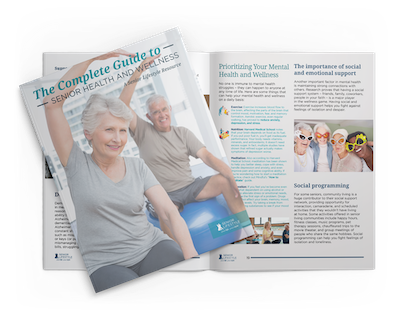Loneliness in seniors is a growing concern as the global population ages. It’s a condition where older adults become isolated through a lack of social interaction, leading to various negative consequences.
According to the University of Michigan National Poll on Healthy Aging, 34% of adults ages 50 to 80 reported feeling isolated from others in the past year. More than one in three (37%) reported feeling a lack of companionship. One in three (33%) reported infrequent contact (once a week or less) with people from outside their home.
Like anyone else, seniors need contact with people – possibly even more so since so many seniors can find themselves alone. Here is more on senior isolation, the associated risks, and what you can do to help.
What Causes Senior Isolation?
Senior isolation refers to the condition where older adults experience a significant reduction in social interactions, often leading to loneliness. This can be due to various factors, such as:
- Health issues
- Lack of transportation
- Loss of a spouse or friends
- Reduced mobility
- Retirement
Isolation is not just about being physically alone; it also involves feeling disconnected and lacking a sense of belonging or purpose.

Download The Complete Guide to Health & Wellness for Seniors
As people grow older, their health and wellness needs change. Read our eBook, “The Complete Guide to Health & Wellness for Seniors” for everything you need to know about staying healthy and happy as we age.
Download the GuideRisks Associated With Senior Isolation
The risks of senior isolation extend beyond emotional well-being and can significantly impact physical health and overall quality of life. Here are some of the key risks:
- Cognitive Decline: Social isolation in seniors has been linked to an increased risk of developing dementia and cognitive decline. However, regular social interaction helps keep the brain active and can improve memory function.
- Mental Health Issues: Isolation can lead to feelings of sadness and hopelessness, contributing to depression. A lack of social interaction can increase anxiety levels.
- Physical Health Decline: Studies have shown that isolated seniors have a higher risk of premature death. Isolation can worsen conditions like hypertension, heart disease, and obesity. Lack of social engagement can also lead to a weakened immune response.
- Reduced Mobility: Isolated seniors are less likely to engage in physical activities, leading to reduced mobility and increased risk of falls.
8 Ways To Help Seniors Combat Isolation
Addressing senior isolation requires a multifaceted approach. Here are some effective strategies and additional ideas to help when older adults become isolated:
1. Promote Social Connections
Encourage their participation in community activities. Local community centers, clubs, and groups often have activities geared towards seniors. Activities like bingo nights, book clubs, and hobby groups can provide regular social interaction.
Regular family interactions can significantly reduce feelings of isolation. Organize family gatherings, celebrate birthdays, and include seniors in family outings.
Teaching seniors to use smartphones, tablets, and social media can help them stay connected with loved ones. Platforms like Skype, Zoom, and FaceTime can facilitate video calls, making distant relatives feel closer.
2. Enhance Accessibility
Ensuring seniors have access to reliable transportation can help them attend social events and appointments. Services like community shuttles, rideshare programs, and volunteer driver services can be invaluable.
Making homes more accessible can encourage seniors to remain active and independent. This can include installing ramps, grab bars, and stairlifts, as well as arranging furniture for easier mobility.
3. Provide Health Support
Encourage regular medical check-ups to monitor and manage health conditions. These visits can also serve as opportunities for social interaction.
Provide access to counseling and mental health services to address issues like depression and anxiety. Telehealth services can be a convenient option for seniors with mobility issues.
4. Encourage Physical Activity
Encourage participation in senior-friendly exercise programs to promote physical health and social interaction. Classes like yoga, tai chi, and water aerobics are often designed for older adults.
Simple activities like walking groups or gardening can help seniors stay active and engaged. Community gardens and nature walks can provide both physical and social benefits.
5. Visit and Connect
Volunteers can regularly visit isolated seniors, providing companionship and support. These visits can include activities like playing games, reading together, or simply having a conversation.
Regular phone calls can offer a lifeline to isolated seniors, helping them feel connected and valued. Organizations can set up phone buddy programs to match volunteers with seniors.
Animals can provide comfort and companionship to seniors. Programs that bring pets to visit seniors in their homes or in community centers can be highly beneficial.
Connecting seniors with pen pals, either with other seniors or younger people, can provide meaningful social interaction and a sense of connection.
6. Promote Lifelong Learning
Encourage seniors to take part in educational programs. Many community colleges and universities offer courses specifically for seniors, ranging from history to art to technology.
Websites like Coursera, Udemy, and Khan Academy offer a wide range of courses that seniors can take from the comfort of their homes.
Many libraries offer classes, workshops, and social events tailored to seniors. They can be a great resource for both learning and social interaction.
7. Foster a Sense of Purpose
Encourage seniors to volunteer. Helping others can provide a sense of purpose and increase social interactions. Opportunities can range from mentoring younger generations to participating in community projects.
Support seniors in pursuing their hobbies and interests. Whether it’s crafting, music, gardening, or cooking, engaging in enjoyable activities can improve mood and reduce feelings of isolation.
Create opportunities for seniors to interact with younger generations. Programs that pair seniors with children or teenagers for activities like storytelling, tutoring, or art projects can be mutually beneficial.
8. Community Engagement
Promote the use of senior centers which often offer a variety of activities and social events. These centers can be a hub for socialization and community involvement.
Many seniors find comfort and community through religious organizations. Encouraging participation in church groups, study groups, and social events can provide strong social support.
Encourage seniors to attend local events such as fairs, festivals, concerts, and farmer’s markets. These events can provide opportunities for social interaction and community engagement.
By combining these strategies, we can create a supportive environment that fosters social connections and improves the quality of life for our senior population.
Live Among Friends at a Senior Lifestyle Community
Senior isolation is a significant issue that can lead to severe mental and physical health problems. However, through community efforts, enhanced accessibility, and proactive health support, we can help mitigate the risks associated with isolation. By fostering social connections and promoting an active lifestyle, we can improve the quality of life for our senior population.
At a Senior Lifestyle community, you’ll find yourself surrounded by new friends and plenty of opportunities for engagement. As you explore your new life, we’ll take care of your daily needs, such as cleaning, cooking meals, and maintaining your living area.
Find out more about Senior Lifestyle or schedule a visit today.

